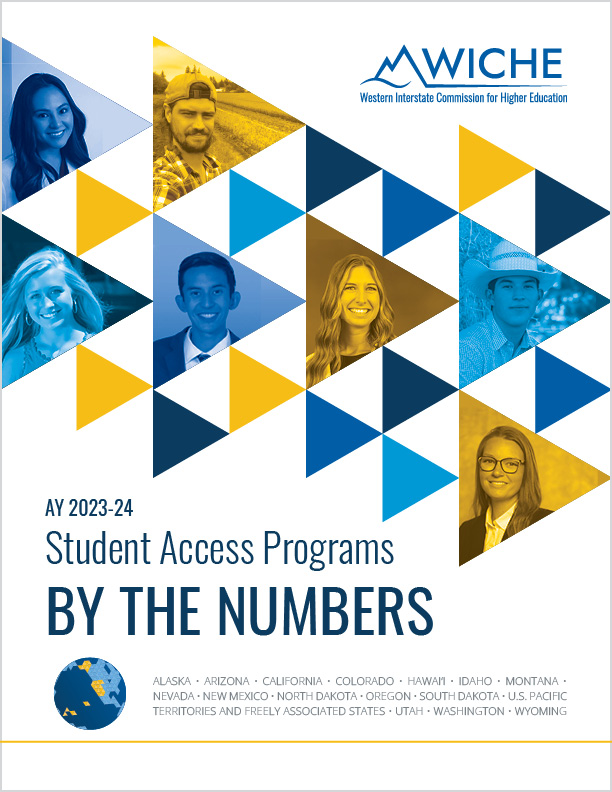Western Undergraduate Exchange (WUE)
WUE Provides Students Greater Access to College with Reduced Tuition Rates at Participating Schools
Going to college out of state may mean paying up to three times more than attending a school or university in your home state/territory*. The Western Undergraduate Exchange (WUE) was established in 1987 to make college more affordable and accessible to students in the West.
Through WUE, students from the WICHE region* can choose from hundreds of undergraduate programs across the West and pay no more than 150% of the institution’s resident tuition rate.
Today, more than 160 public colleges and universities offer reduced tuition rates through WUE to qualifying students. Participating schools offer these discounted rates to help students avoid the full cost of pursuing higher education outside their home state and minimize the impact of student loan debt.
Find your perfect match. Download the list of WUE schools and use the online WUE Tuition Savings Finder to see how much you can save.
*Residents of the following states and territories are eligible to apply for WUE: Alaska, Arizona, California, Colorado, Hawai’i, Idaho, Montana, Nevada, New Mexico, North Dakota, Oregon, South Dakota, Utah, Washington, Wyoming, as well as American Samoa, the Commonwealth of the Northern Mariana Islands, and Guam.

“It has always been a goal of mine to remove the financial burden of tuition from my parents’ shoulders. WUE made this possible.”
Ethan California Resident, Bachelor of Science in Forestry, Oregon State University
How WUE Works
Participating colleges and universities set their own WUE eligibility criteria and manage their WUE rates independently — each school is different.
If you have questions about admission criteria or WUE rates and eligibility, contact the admissions, scholarship, and/or financial aid office at your select school. Contact information for each school is available on the WUE Tuition Savings Finder.
Use this checklist to determine your WUE eligibility and find the resources you need to apply for the WUE rate. Remember: some schools have separate applications for admission and for WUE, so be sure to contact your desired institution to learn more.
There are three criteria for eligibility: 1) You must be a resident of the WICHE region. 2) Your desired school must also be in the WICHE region and 3) it must also offer the WUE rate.
Use the WUE Tuition Savings Finder to see which majors are eligible for the WUE rate by school.
Each school administers WUE differently: Institutions may require a minimum GPA, exclude selected majors, have early application deadlines, and/or limit the number of students awarded the WUE rate. Use the WUE Tuition Savings Finder and contact your school of interest directly about their specific WUE requirements.
Follow the application steps for your select school and submit the required documents by the application deadline. Contact the school’s admissions, financial aid, or scholarship office to let them know you’re seeking the WUE rate. Contact information for each school is available on the WUE Tuition Savings Finder.
Common Questions About Tuition Savings Answered
Founded in 1987, the Western Undergraduate Exchange (WUE, pronounced “woo-wee”) is a regional tuition savings agreement administered by the Western Interstate Commission for Higher Education (WICHE); the first WUE exchanges began in 1988. WUE enables eligible students to enroll as nonresidents in 160+ participating public colleges and universities and pay 150% (or less) of the enrolling institution’s resident tuition—annually saving students an average of $11,834 each on the cost of nonresident tuition.
More than 160 public two- and four-year undergraduate WICHE-region colleges and universities participate in WUE. Download the WUE Handout for a full list of participating schools. Or, use our WUE Savings Finder to see if a school that you’re interested in participates. Private institutions are not eligible for WUE participation.
Residents of the following states and territories are eligible to apply for WUE: Alaska, Arizona, California, Colorado, Hawai’i, Idaho, Montana, Nevada, New Mexico, North Dakota, Oregon, South Dakota, Utah, Washington, Wyoming, as well as American Samoa, the Commonwealth of the Northern Mariana Islands, and Guam.
Apply directly to your chosen WUE college or university (and not to WICHE itself). Some schools have special eligibility requirements or annual WUE admission quotas, found in the school’s WUE Savings Finder profile. If you still have questions, contact the school’s office that administers WUE (admissions, financial aid, or the scholarship office), as indicated on the school’s WUE Savings Finder profile. Some institutions automatically consider applicants from a WICHE state for the WUE rate, but many require that applicants request the WUE rate when applying for admission. Check to see if they have a special WUE application.
No. To be eligible, students must reside in one of the 15 states or three U.S. territories in the WICHE region. Visit wiche.testing.brossgroup.com/our-region to learn more.
The majority of WUE schools accept transfer students, but some only offer the WUE rate to first-year students. Certain schools offer some, but not all, majors at the WUE rate to transfer students. Some majors are only available to first-year students (at some schools). Check your chosen school’s profile in the WUE Savings Finder to learn more.
Applying for WUE: Helpful Terms to Know
Western Undergraduate Exchange. WUE (pronounced woo-wee) is a tuition savings program that helps students reduce the cost of going to college in the Western U.S.
Western Interstate Commission for Higher Education (pronounced wit-chee).
A prospective college student who is a resident of one of the 15 WICHE-region states or territories looking to attend college at a participating college or university in another Western state/territory.
The amount that colleges and universities charge students for education. Typically covers the cost of classes but does not include other expenses such as room and board, books, or supplies.
Sometimes called in-state tuition, resident tuition refers to the lower tuition rate that students who attend a public university or college in their state pay. This rate is typically lower than the rate charged to students who enroll from out of state because the state government subsidizes tuition for its residents. Schools participating in WUE agree to charge nonresident students from WICHE member states/jurisdictions no more than 150 percent of the resident tuition rate
Sometimes called out-of-state tuition, nonresident tuition refers to the higher tuition rate that students who attend a public college or university outside their home state of residency pay. In some cases, nonresident tuition can be up to 300 percent more than resident tuition. WUE is a tuition savings program that helps reduce the cost of college in another state/territory in the WICHE region.
A scholarship is a financial award given to a student to help cover tuition costs. It does not need to be repaid. Scholarships are usually awarded based on academic criteria, financial need, athletic ability, and/or community service. WUE is not a scholarship; however, some institutions may use this term to describe WUE because it is a tuition savings program.
A grant is another form of financial aid that can help students pay for their education. Grants are typically need-based or awarded for specific academic studies. Grants do not need to be repaid and are often available from the government, private organizations, schools, and more.
Loan: A loan is a sum of money borrowed to help pay for tuition and other college costs. Unlike scholarships, grants, and WUE, loans must be repaid with interest.
Still have questions? Visit our complete list of Frequently Asked Questions.

